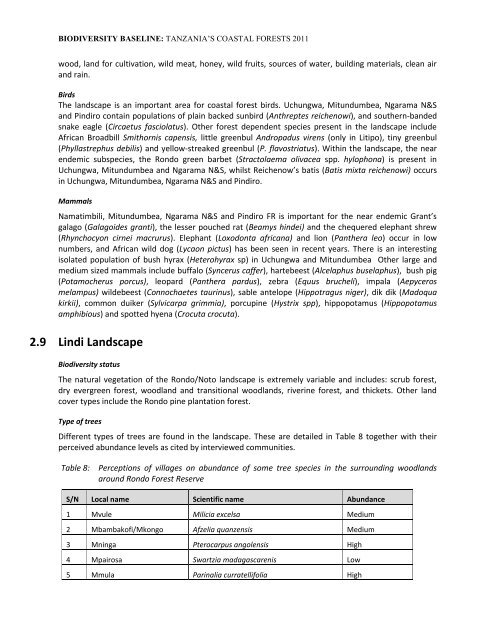Neil D. Burgess, Paul Harrison, Peter Sumbi, James Laizer, Adam ...
Neil D. Burgess, Paul Harrison, Peter Sumbi, James Laizer, Adam ...
Neil D. Burgess, Paul Harrison, Peter Sumbi, James Laizer, Adam ...
You also want an ePaper? Increase the reach of your titles
YUMPU automatically turns print PDFs into web optimized ePapers that Google loves.
BIODIVERSITY BASELINE: TANZANIA’S COASTAL FORESTS 2011<br />
wood, land for cultivation, wild meat, honey, wild fruits, sources of water, building materials, clean air<br />
and rain.<br />
Birds<br />
The landscape is an important area for coastal forest birds. Uchungwa, Mitundumbea, Ngarama N&S<br />
and Pindiro contain populations of plain backed sunbird (Anthreptes reichenowi), and southern-banded<br />
snake eagle (Circaetus fasciolatus). Other forest dependent species present in the landscape include<br />
African Broadbill Smithornis capensis, little greenbul Andropadus virens (only in Litipo), tiny greenbul<br />
(Phyllastrephus debilis) and yellow-streaked greenbul (P. flavostriatus). Within the landscape, the near<br />
endemic subspecies, the Rondo green barbet (Stractolaema olivacea spp. hylophona) is present in<br />
Uchungwa, Mitundumbea and Ngarama N&S, whilst Reichenow’s batis (Batis mixta reichenowi) occurs<br />
in Uchungwa, Mitundumbea, Ngarama N&S and Pindiro.<br />
Mammals<br />
Namatimbili, Mitundumbea, Ngarama N&S and Pindiro FR is important for the near endemic Grant’s<br />
galago (Galagoides granti), the lesser pouched rat (Beamys hindei) and the chequered elephant shrew<br />
(Rhynchocyon cirnei macrurus). Elephant (Loxodonta africana) and lion (Panthera leo) occur in low<br />
numbers, and African wild dog (Lycaon pictus) has been seen in recent years. There is an interesting<br />
isolated population of bush hyrax (Heterohyrax sp) in Uchungwa and Mitundumbea Other large and<br />
medium sized mammals include buffalo (Syncerus caffer), hartebeest (Alcelaphus buselaphus), bush pig<br />
(Potamocherus porcus), leopard (Panthera pardus), zebra (Equus brucheli), impala (Aepyceros<br />
melampus) wildebeest (Connochaetes taurinus), sable antelope (Hippotragus niger), dik dik (Madoqua<br />
kirkii), common duiker (Sylvicarpa grimmia), porcupine (Hystrix spp), hippopotamus (Hippopotamus<br />
amphibious) and spotted hyena (Crocuta crocuta).<br />
2.9 Lindi Landscape<br />
Biodiversity status<br />
The natural vegetation of the Rondo/Noto landscape is extremely variable and includes: scrub forest,<br />
dry evergreen forest, woodland and transitional woodlands, riverine forest, and thickets. Other land<br />
cover types include the Rondo pine plantation forest.<br />
Type of trees<br />
Different types of trees are found in the landscape. These are detailed in Table 8 together with their<br />
perceived abundance levels as cited by interviewed communities.<br />
Table 8: Perceptions of villages on abundance of some tree species in the surrounding woodlands<br />
around Rondo Forest Reserve<br />
S/N Local name Scientific name Abundance<br />
1 Mvule Milicia excelsa Medium<br />
2 Mbambakofi/Mkongo Afzelia quanzensis Medium<br />
3 Mninga Pterocarpus angolensis High<br />
4 Mpairosa Swartzia madagascarenis Low<br />
5 Mmula Parinalia curratellifolia High

















